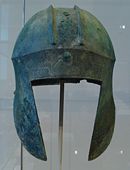
Illyrian type helmet
Encyclopedia

Archaeology
Archaeology, or archeology , is the study of human society, primarily through the recovery and analysis of the material culture and environmental data that they have left behind, which includes artifacts, architecture, biofacts and cultural landscapes...
term that describes a style of bronze
Bronze
Bronze is a metal alloy consisting primarily of copper, usually with tin as the main additive. It is hard and brittle, and it was particularly significant in antiquity, so much so that the Bronze Age was named after the metal...
helmet
Helmet
A helmet is a form of protective gear worn on the head to protect it from injuries.Ceremonial or symbolic helmets without protective function are sometimes used. The oldest known use of helmets was by Assyrian soldiers in 900BC, who wore thick leather or bronze helmets to protect the head from...
, which in its later variations covered the entire head and neck, and was open-faced in all of its subsequent forms. Its earliest styles were first developed in Ancient Greece
Ancient Greece
Ancient Greece is a civilization belonging to a period of Greek history that lasted from the Archaic period of the 8th to 6th centuries BC to the end of antiquity. Immediately following this period was the beginning of the Early Middle Ages and the Byzantine era. Included in Ancient Greece is the...
, specifically in the Peloponnese
Peloponnese
The Peloponnese, Peloponnesos or Peloponnesus , is a large peninsula , located in a region of southern Greece, forming the part of the country south of the Gulf of Corinth...
, during the 8th and 7th centuries BC (700-640 BC). Accurate representations on Corinthian
Ancient Corinth
Corinth, or Korinth was a city-state on the Isthmus of Corinth, the narrow stretch of land that joins the Peloponnesus to the mainland of Greece, roughly halfway between Athens and Sparta. The modern town of Corinth is located approximately northeast of the ancient ruins...
vases are sufficient to indicate that the "Illyrian" type helmet was developed before 600 BC. The helmet was misleadingly named as an "Illyrian" type due to a large number of early finds coming from Illyria
Illyria
In classical antiquity, Illyria was a region in the western part of the Balkan Peninsula inhabited by the Illyrians....
.
Archaeology
According to the archaeological evidence, the "Illyrian" type helmet evolved from the KegelhelmKegelhelm
The Kegelhelm or Kegel type is a type of helmet that originated in ancient Greece and the progenitor of many Greek helmets especially that of the "Illyrian" type helmet.It was open faced was made of five piece and a high-crest holder.It did not outlast the eighth century BC. The helmet is conical...
(or Kegel type) of the Archaic Period
Archaic Period
The name Archaic Period is given by archaeologists to the earliest periods of a culture. In particular, it may refer to:* the Archaic period in the Americas * the Archaic period in Greece...
found in Argos
Argos
Argos is a city and a former municipality in Argolis, Peloponnese, Greece. Since the 2011 local government reform it is part of the municipality Argos-Mykines, of which it is a municipal unit. It is 11 kilometres from Nafplion, which was its historic harbour...
. The earliest "Illyrian" type helmets were developed in a workshop located in the northwestern Peloponnese (possibly Olympia
Olympia, Greece
Olympia , a sanctuary of ancient Greece in Elis, is known for having been the site of the Olympic Games in classical times, comparable in importance to the Pythian Games held in Delphi. Both games were held every Olympiad , the Olympic Games dating back possibly further than 776 BC...
), although the first Type II "Illyrian" helmets were created in Corinthian
Corinth
Corinth is a city and former municipality in Corinthia, Peloponnese, Greece. Since the 2011 local government reform it is part of the municipality Corinth, of which it is the seat and a municipal unit...
workshops. The first Type III helmets were created in workshops situated somewhere on the Illyrian coast of the Adriatic. The "Illyrian" type helmet did not obstruct the wearer's critical senses of vision
Visual perception
Visual perception is the ability to interpret information and surroundings from the effects of visible light reaching the eye. The resulting perception is also known as eyesight, sight, or vision...
though the first two varieties hampered hearing
Hearing (sense)
Hearing is the ability to perceive sound by detecting vibrations through an organ such as the ear. It is one of the traditional five senses...
. There were four types of these helmets and all were open faced.
- Type I (ca. 700 BC-640 BC) left the neck unprotected and hampered hearing.
- Type II (ca. 600 BC) offered neck protection and again hampered hearing.
- Type III (ca. 550 BC) offered neck protection and allowed better hearing.
- Type IV (ca. 500 BC) was similar to Type III but hearing was not impaired at all.
The Illyrian type helmet was used by the Ancient Greeks, Etruscans, Scythians, and became popular with the Illyrians
Illyrians
The Illyrians were a group of tribes who inhabited part of the western Balkans in antiquity and the south-eastern coasts of the Italian peninsula...
who later adopted it. A variety of the helm had also spread to Italy
Italy
Italy , officially the Italian Republic languages]] under the European Charter for Regional or Minority Languages. In each of these, Italy's official name is as follows:;;;;;;;;), is a unitary parliamentary republic in South-Central Europe. To the north it borders France, Switzerland, Austria and...
based on its appearance on ivory reliefs and on a silver bowl at the "Bernardini" tomb at Praeneste. The helmet became obsolete in most parts of Greece in the early 5th century BC. Its use in Illyria
Illyria
In classical antiquity, Illyria was a region in the western part of the Balkan Peninsula inhabited by the Illyrians....
had ended by the 4th century BC.

